Quality Detection Method of Penaeus vannamei Based on Lightweight YOLOv5s Network
Abstract
1. Introduction
2. Materials and Methods
2.1. YOLOv5 Model
2.2. Shrimp-Yolov5s Model
2.3. Dataset Preparation
2.4. Assessment Indicators
3. Results and Discussion
3.1. Training Process
3.2. Ablation Experiments
3.3. Comparison of Network
4. Conclusions
Author Contributions
Funding
Institutional Review Board Statement
Informed Consent Statement
Data Availability Statement
Conflicts of Interest
References
- Fishery Bureau of the Ministry of Agriculture (FBMA). China Fishery Statistical Yearbook; China Agriculture Publishing House (Chapter 2): Beijing, China, 2021. [Google Scholar]
- Yin, S.; Han, F.; Chen, M.; Li, K.; Li, Q. Chinese urban consumers’ preferences for white shrimp: Interactions between organic labels and traceable information. Aquaculture 2020, 521, 735047. [Google Scholar] [CrossRef]
- Kanduri, L.; Eckhardt, R.A. Food Safety in Shrimp Processing: A Handbook for Shrimp Processors, Importers, Exporters and Retailers; John Wiley & Sons: Hoboken, NJ, USA, 2008. [Google Scholar]
- Hannan, M.A.; Habib, K.A.; Shahabuddin, A.M.; Haque, M.A.; Munir, M.B. Processing of Shrimp. In Post-Harvest Processing, Packaging and Inspection of Frozen Shrimp: A Practical Guide; Springer: Singapore, 2022; pp. 60–61. [Google Scholar]
- Fotedar, S.; Evans, L.H. Health management during handling and live transport of crustaceans: A review. J. Invertebr. Pathol. 2011, 106, 143–152. [Google Scholar] [CrossRef] [PubMed]
- NY/T 840-2020; Green Food Shrimp. The National Agriculture Ministry: Beijing, China, 2020.
- Yu, X.; Tang, L.; Wu, X.; Lu, H. Nondestructive Freshness Discriminating of Shrimp Using Visible/Near-Infrared Hyperspectral Imaging Technique and Deep Learning Algorithm. Food Anal. Methods 2018, 11, 768–780. [Google Scholar] [CrossRef]
- Liu, Z.; Jia, X.; Xu, X. Study of shrimp recognition methods using smart networks. Comput. Electron. Agric. 2019, 165, 104926. [Google Scholar] [CrossRef]
- Hu, W.C.; Wu, H.T.; Zhang, Y.F.; Zhang, S.H.; Lo, C.H. Shrimp recognition using ShrimpNet based on convolutional neural network. J. Ambient. Intell. Humaniz. Comput. 2020, 1–8. [Google Scholar] [CrossRef]
- Prema, K.; Visumathi, J. An Improved Non-Destructive Shrimp Freshness Detection Method Based on Hybrid CNN and SVM with GAN Augmentation. In Proceedings of the International Conference on Advances in Computing, Communication and Applied Informatics (ACCAI), Chennai, India, 28–29 January 2022; pp. 1–7. [Google Scholar]
- Redmon, J.; Divvala, S.; Girshick, R.; Farhadi, A. You Only Look Once: Unified, Real-Time Object Detection. In Proceedings of the IEEE Conference on Computer Vision and Pattern Recognition (CVPR), Las Vegas, NV, USA, 27–30 June 2016; pp. 779–788. [Google Scholar]
- Redmon, J.; Farhadi, A. YOLO9000: Better, Faster, Stronger. In Proceedings of the IEEE Conference on Computer Vision and Pattern Recognition (CVPR), Honolulu, HI, USA, 21–26 July 2017; pp. 6517–6525. [Google Scholar]
- Joseph, R.; Ali, F. YOLOv3: An Incremental Improvement. arXiv 2018, arXiv:1804.02767. [Google Scholar]
- Bochkovskiy, A.; Wang, C.; Liao, H. YOLOv4: Optimal Speed and Accuracy of Object Detection. arXiv 2020, arXiv:2004.10934. [Google Scholar]
- Jocher, G. YOLOv5. Available online: https://github.com/ultralytics/yolov5 (accessed on 1 November 2021).
- Li, C.; Li, L.; Jiang, H.; Weng, K.; Geng, Y.; Li, L.; Ke, Z.; Li, Q.; Cheng, M.; Nie, W.; et al. YOLOv6: A Single-Stage Object Detection Framework for Industrial Applications. arXiv 2022, arXiv:2209.02976. [Google Scholar]
- Wang, C.; Bochkovskiy, A.; Liao, H. YOLOv7: Trainable bag-of-freebies sets new state-of-the-art for real-time object detectors. arXiv 2022, arXiv:2207.02696. [Google Scholar]
- Liu, Z.; Wang, S. Broken Corn Detection Based on an Adjusted YOLO With Focal Loss. IEEE Access 2019, 7, 68281–68289. [Google Scholar] [CrossRef]
- Jubayer, F.; Soeb, J.A.; Mojumder, A.N.; Paul, M.K.; Barua, P.; Kayshar, S.; Akter, S.S.; Rahman, M.; Islam, A. Detection of mold on the food surface using YOLOv5. Curr. Res. Food Sci. 2021, 4, 724–728. [Google Scholar] [CrossRef] [PubMed]
- Han, W.; Jiang, F.; Zhu, Z. Detection of Cherry Quality Using YOLOV5 Model Based on Flood Filling Algorithm. Foods 2022, 11, 1127. [Google Scholar] [CrossRef] [PubMed]
- Cui, C.; Gao, T.; Wei, S.; Du, Y.; Guo, R.; Dong, S.; Lu, B.; Zhou, Y.; Lv, X.; Liu, Q.; et al. PP-LCNet: A Lightweight CPU Convolutional Neural Network. arXiv 2021, arXiv:2109.15099. [Google Scholar]
- Ge, D.H.; Li, H.; Zhang, L.; Liu, R.; Shen, P.; Miao, Q.G. Survey of Lightweight Neural Network. J. Softw. 2020, 31, 2627–2653. (In Chinese) [Google Scholar]
- Howard, A.G.; Zhu, M.; Chen, B.; Kalenichenko, D.; Wang, W.; Weyand, T.; Andreetto, M.; Adam, H. Mobilenets: Efficient convolutional neural networks for mobile vision applications. arXiv 2017, arXiv:1704.04861. [Google Scholar]
- Ding, X.; Zhang, X.; Han, J.; Ding, G. Scaling Up Your Kernels to 31 × 31: Revisiting Large Kernel Design in CNNs. In Proceedings of the IEEE Conference on Computer Vision and Pattern Recognition (CVPR), New Orleans, LA, USA, 18–24 June 2022; pp. 11953–11965. [Google Scholar]
- Chollet, F. Xception: Deep Learning with Depthwise Separable Convolutions. In Proceedings of the IEEE Conference on Computer Vision and Pattern Recognition (CVPR), Honolulu, HI, USA, 21–26 July 2017; pp. 1800–1807. [Google Scholar]
- Elfwing, S.; Uchibe, E.; Doya, K. Sigmoid-weighted linear units for neural network function approximation in reinforcement learning. Neural Netw. 2018, 107, 3–11. [Google Scholar] [CrossRef] [PubMed]
- Ramachandran, P.; Zoph, B.; Le, Q.V. Searching for activation functions. arXiv 2017, arXiv:1710.05941. [Google Scholar]
- GB 2733-2015; Hygienic Standard for Fresh and Frozenmarine Products of Animal Origin. The National Hygiene Ministry: Beijing, China, 2015.
- Ge, Z.; Liu, S.; Wang, F.; Li, Z.; Sun, J. Yolox: Exceeding yolo series in 2021. arXiv 2021, arXiv:2107.08430. [Google Scholar]
- Liu, W.; Anguelov, D.; Erhan, D.; Szegedy, C.; Reed, S.; Fu, C.Y.; Berg, A.C. SSD: Single Shot MultiBox Detector. In Proceedings of the Computer Vision—ECCV 2016; Lecture Notes in Computer Science; Springer: Cham, Switzerland, 2016; p. 9905. [Google Scholar]
- Ren, S.; He, K.; Girshick, R.; Sun, J. Faster R-CNN: Towards Real-Time Object Detection with Region Proposal Networks. arXiv 2015, arXiv:1506.01497. [Google Scholar] [CrossRef] [PubMed]

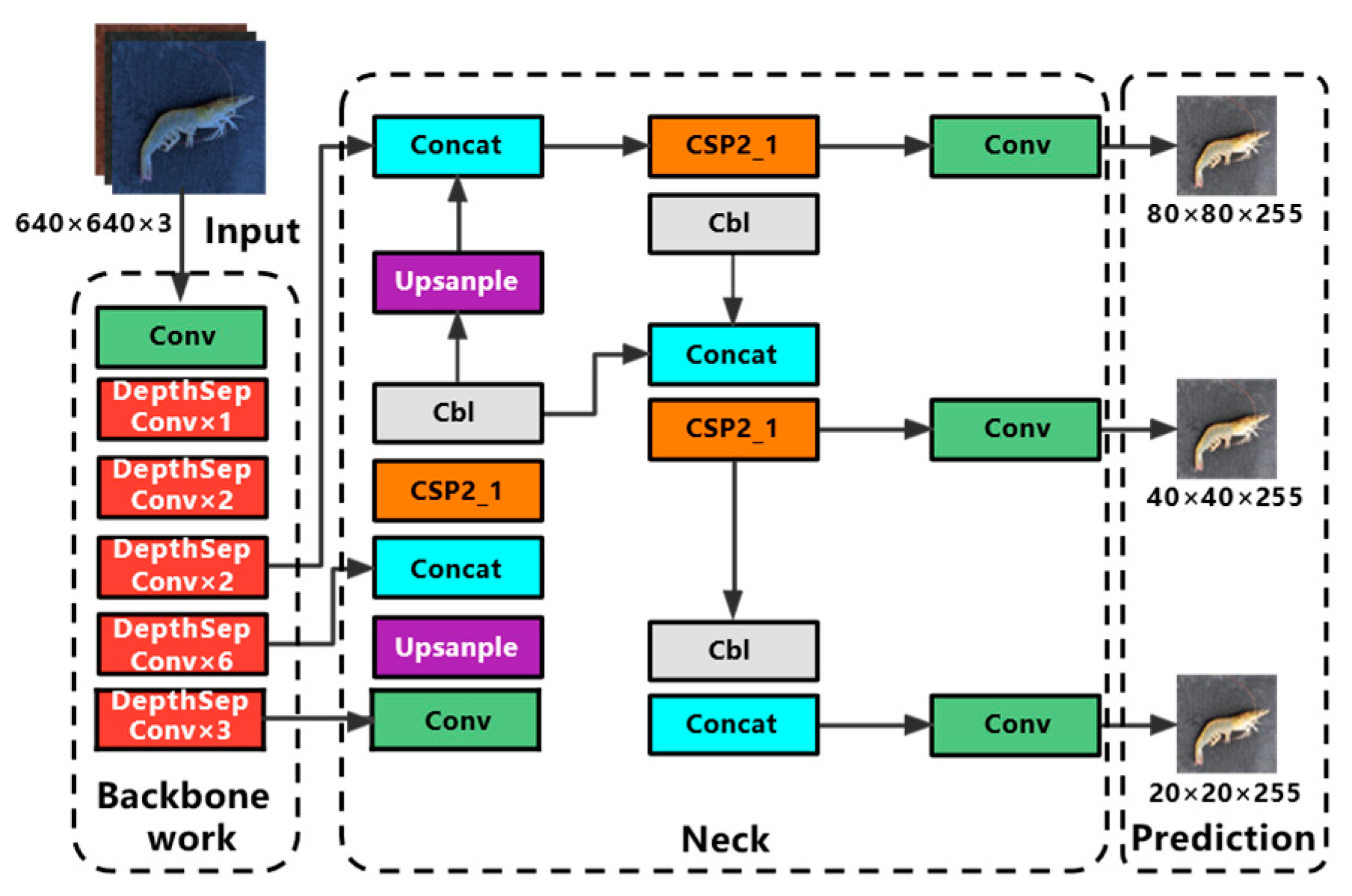




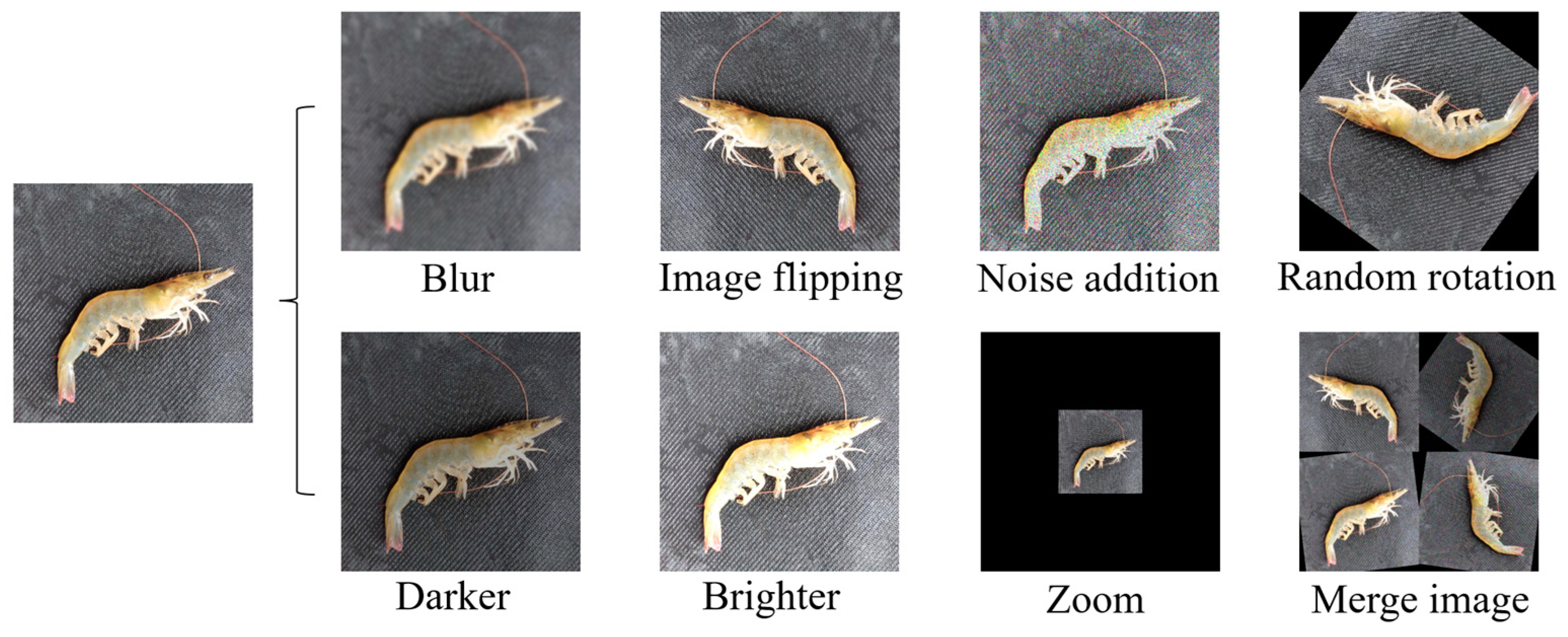
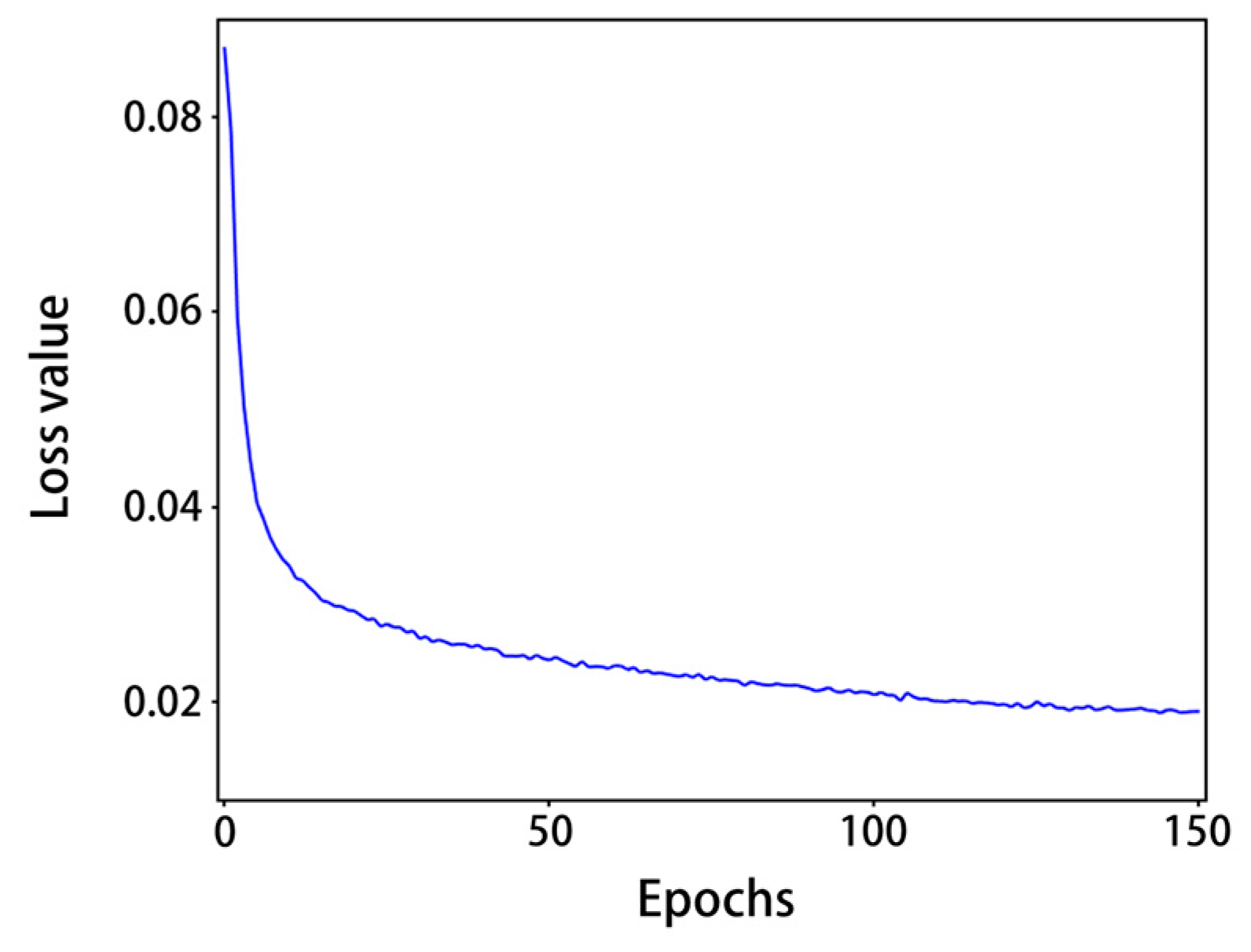
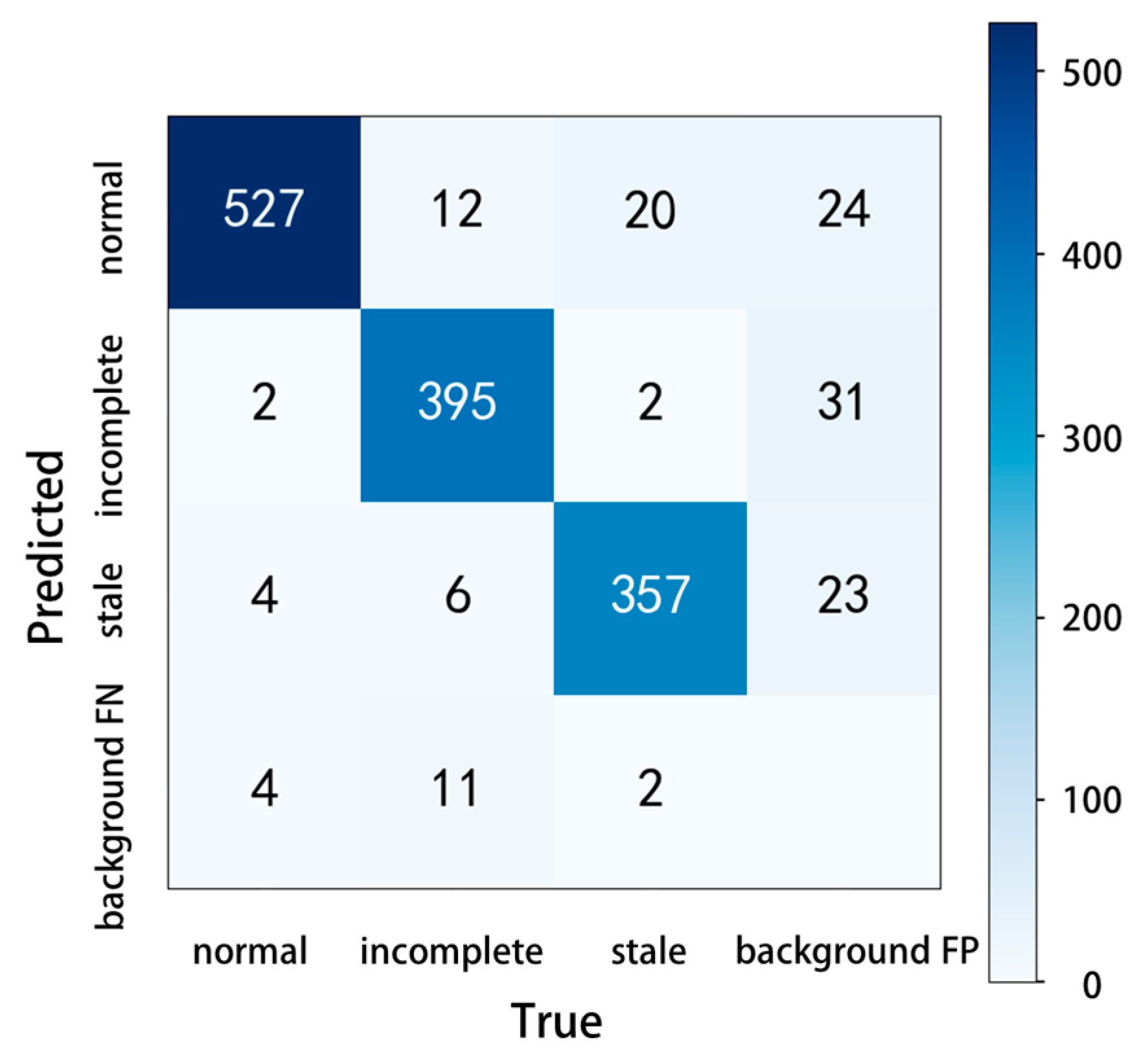
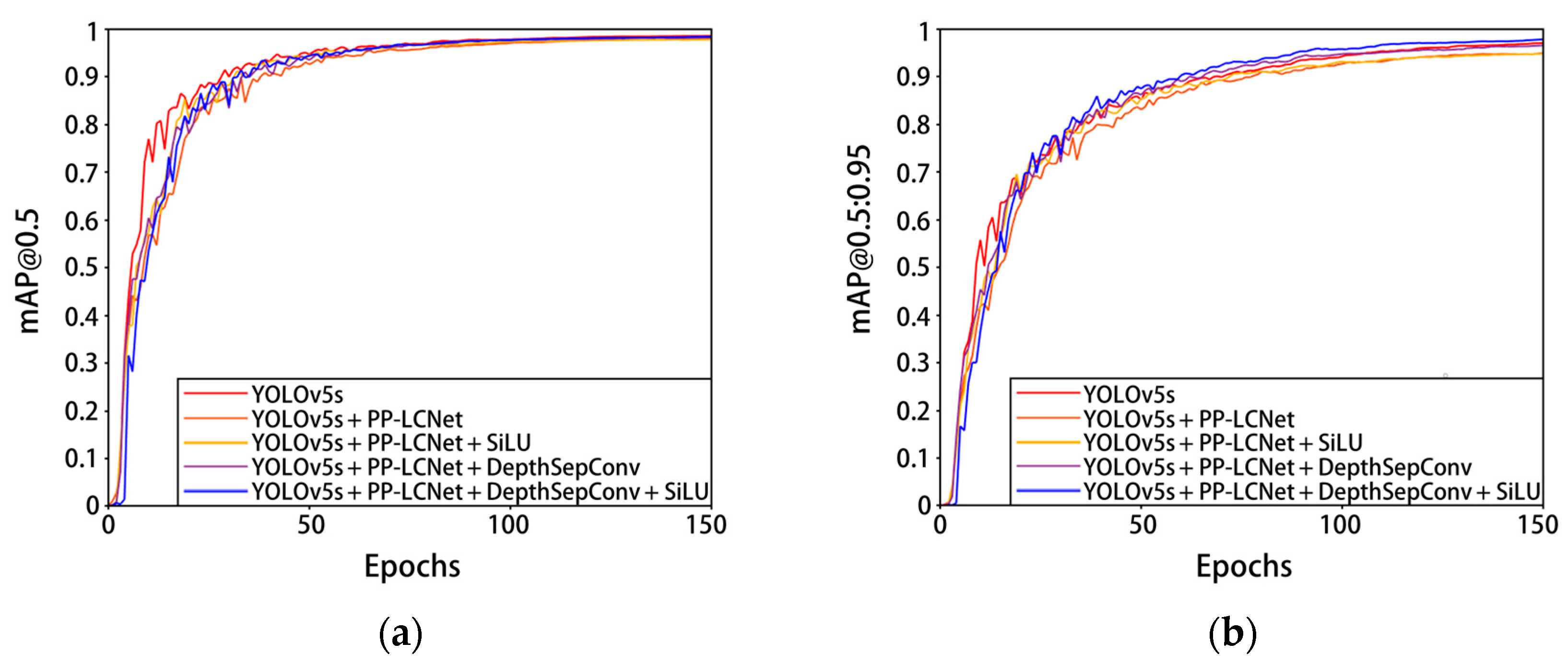
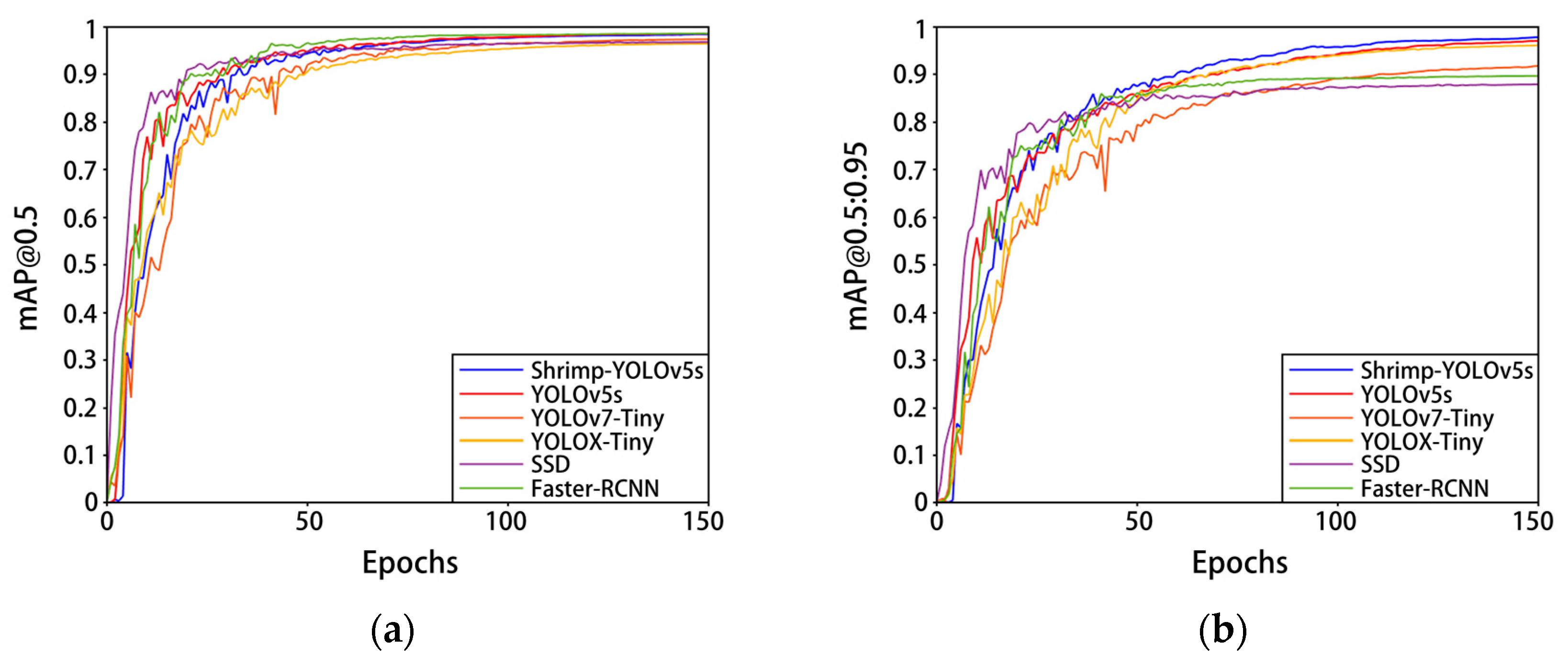
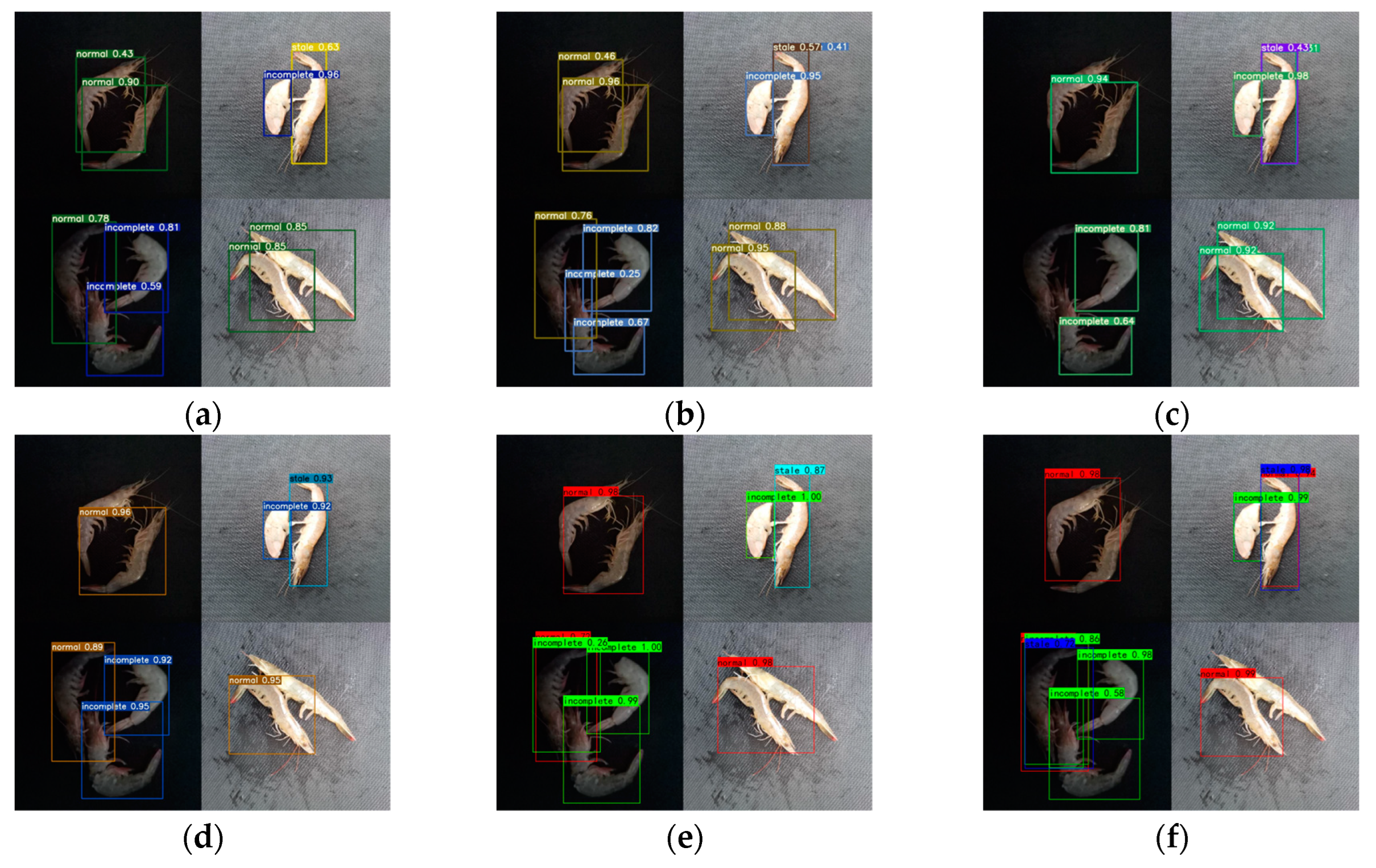
| Model | Layers | Params(M) | FLOPs(G) |
|---|---|---|---|
| YOLOv5s | 283 | 7.1 | 16.3 |
| YOLOv5s + PP-LCNet | 328 | 3.8 | 8.2 |
| YOLOv5s + PP-LCNet + DepthSepConv | 343 | 4.8 | 9.0 |
| Configuration | Parameters | Value/Version |
|---|---|---|
| Software | Operating system | ubuntu18.04 |
| GPU acceleration environments | Cuda 10.1 | |
| Training framework | PyTorch 1.7.0 | |
| Hardware | GPU | NVIDIA GeForce RTX 2080 Ti |
| CPU | Intel(R) Xeon(R) Silver 4110 CPU @2.10 GHz | |
| RAM | 16 GB | |
| VRAM | 11 GB | |
| Training parameters | Image size | 640 × 640 |
| Batch size | 32 | |
| Learning rate | 0.01 | |
| Momentum | 0.937 | |
| Weight decay | 0.0005 | |
| Epoch | 150 | |
| Optimizer | SGD |
| Labels | Precision | Recall | mAP@0.5 | mAP@0.5:0.95 |
|---|---|---|---|---|
| normal | 96.8% | 94.1% | 98.2% | 88.2% |
| incomplete | 93.9% | 95.5% | 98.2% | 84.8% |
| stale | 95.1% | 97.9% | 98.7% | 91.1% |
| All | 95.8% | 95.2% | 98.5% | 88.1% |
| Model | Image Size | mAP@0.5:0.95 | mAP@0.5 | Params(M) | FLOPs(G) | FPS |
|---|---|---|---|---|---|---|
| YOLOv5s | 640 × 640 | 87.4 | 98.6 | 7.1 | 16.3 | 238.1 |
| YOLOv5s + PP-LCNet | 640 × 640 | 85.6 | 97.7 | 3.8 | 8.2 | 252.1 |
| YOLOv5s + PP-LCNet+SiLU | 640 × 640 | 85.4 | 97.8 | 3.8 | 8.2 | 263.2 |
| YOLOv5s + PP-LCNet + DepthSepConv | 640 × 640 | 86.9 | 98.3 | 4.8 | 9.0 | 251.3 |
| YOLOv5s + PP-LCNet + DepthSepConv + SiLU | 640 × 640 | 88.1 | 98.5 | 4.8 | 9.0 | 272.8 |
| Model | Image Size | mAP@0.5:0.95 | mAP@0.5 | Params(M) | FLOPs(G) | FPS |
|---|---|---|---|---|---|---|
| Shrimp-YOLOv5s | 640 × 640 | 88.1 | 98.5 | 4.8 | 9.0 | 272.8 |
| YOLOv5s [15] | 640 × 640 | 87.4 | 98.6 | 7.1 | 16.3 | 238.1 |
| YOLOv7-Tiny [17] | 640 × 640 | 82.6 | 97.4 | 6.0 | 13.2 | 253.2 |
| YOLOX-Tiny [29] | 640 × 640 | 86.5 | 96.5 | 5.0 | 15.23 | 208.3 |
| SSD [30] | 640 × 640 | 79.1 | 96.8 | 26.3 | 282.0 | 38.7 |
| Faster-RCNN [31] | 640 × 640 | 80.7 | 98.6 | 136.7 | 401.7 | 29.2 |
Disclaimer/Publisher’s Note: The statements, opinions and data contained in all publications are solely those of the individual author(s) and contributor(s) and not of MDPI and/or the editor(s). MDPI and/or the editor(s) disclaim responsibility for any injury to people or property resulting from any ideas, methods, instructions or products referred to in the content. |
© 2023 by the authors. Licensee MDPI, Basel, Switzerland. This article is an open access article distributed under the terms and conditions of the Creative Commons Attribution (CC BY) license (https://creativecommons.org/licenses/by/4.0/).
Share and Cite
Chen, Y.; Huang, X.; Zhu, C.; Tang, S.; Zhao, N.; Xiao, W. Quality Detection Method of Penaeus vannamei Based on Lightweight YOLOv5s Network. Agriculture 2023, 13, 690. https://doi.org/10.3390/agriculture13030690
Chen Y, Huang X, Zhu C, Tang S, Zhao N, Xiao W. Quality Detection Method of Penaeus vannamei Based on Lightweight YOLOv5s Network. Agriculture. 2023; 13(3):690. https://doi.org/10.3390/agriculture13030690
Chicago/Turabian StyleChen, Yanyi, Xuhong Huang, Cunxin Zhu, Shengping Tang, Nan Zhao, and Weihao Xiao. 2023. "Quality Detection Method of Penaeus vannamei Based on Lightweight YOLOv5s Network" Agriculture 13, no. 3: 690. https://doi.org/10.3390/agriculture13030690
APA StyleChen, Y., Huang, X., Zhu, C., Tang, S., Zhao, N., & Xiao, W. (2023). Quality Detection Method of Penaeus vannamei Based on Lightweight YOLOv5s Network. Agriculture, 13(3), 690. https://doi.org/10.3390/agriculture13030690





